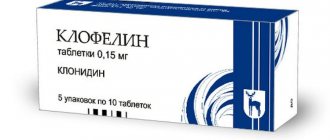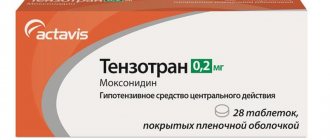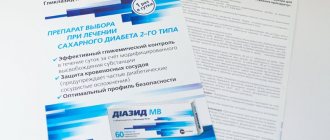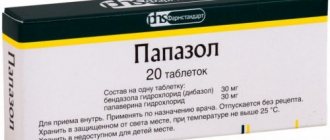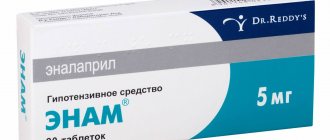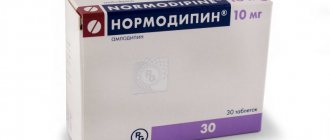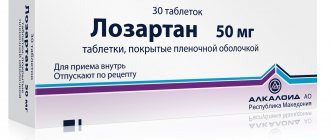Pharmacodynamics and pharmacokinetics
Pharmacodynamics
Non-selective beta-blocker with moderate antihypertensive, antianginal and antiarrhythmic effects. Indiscriminately blocks beta-adrenergic receptors , weakens catecholamine- biosynthesis of cAMP from ATP , after which it reduces the intracellular supply of calcium ions, has a negative dromotropic , bathmotropic , chronotropic and inotropic effect (reduces heartbeat, inhibits conductivity and excitability, reduces the ability of the myocardium to contract).
On the first day of using the drug, peripheral vascular resistance increases (as a result of an increase in the activity of alpha-adrenergic receptors and blocking of beta-2-adrenergic receptors in muscle vessels), but after two days its value returns to its original value, and with long-term administration it decreases.
The antihypertensive effect is associated with a decrease in cardiac output, a weakening of sympathetic stimulation of the vessels of peripheral organs, inhibition of the renin-angiotensin system , a decrease in the sensitivity of aortic arch pressure receptors and an effect on the nervous system. This antihypertensive effect is completely stabilized by the end of the second week of the course of administration of the drug.
The antianginal effect is caused by a decrease in the heart's oxygen demand (due to negative inotropic and chronotropic effects). A decrease in heart rate leads to prolongation of diastole and increased myocardial perfusion. As a result of increased diastolic pressure in the left side of the heart and increased stretching of the ventricular muscles, the need for oxygen and nutrients may increase, especially in patients suffering from heart failure .
The antiarrhythmic effect manifests itself as a result of blocking arrhythmogenic factors (excessive activity of the sympathetic system, tachycardia , increased levels of cAMP in tissues, arterial hypertension ), reducing the speed of spontaneous excitation of ectopic and sinus pacemakers and inhibition of AV conduction . Suppression of impulse conduction is recorded primarily in the forward direction and, to a lesser extent, in the reverse direction through the AV node and along additional pathways. Due to a decrease in the heart's oxygen demand, the severity of cardiac ischemia is weakened, and post-infarction mortality may decrease due to the antiarrhythmic effect .
The ability to prevent the occurrence of headaches of vascular etiology is caused by a decrease in the severity of enlargement of the cerebral arteries due to blocking of beta-adrenergic receptors of platelet adhesion and lipolysis caused by catecholamines adhesiveness , inhibition of activation of blood coagulation factors during the release of adrenaline , stimulation of oxygen transport into tissues and weakening of renin .
The decrease in the severity of tremor with the use of propranolol is due to the blocking of beta-2 adrenergic receptors.
The drug enhances the ability of the uterus to contract. Stimulates the tone of the bronchial walls.
Pharmacokinetics
After internal administration, up to 90% of the product is quickly absorbed. The maximum concentration in the blood occurs after an hour and a half. Bioavailability after a single dose reaches 40%, with long-term use it increases. The value of bioavailability depends on the nature of the meal and the intensity of liver perfusion.
The drug is highly lipophilic and accumulates in the kidneys, brain, lungs and heart. Penetrates through histohematic barriers and is excreted in breast milk. Reaction with blood proteins is 90-95%.
Transformed in the liver by glucuronidation. Then it enters the intestine with bile, where it is deglucuronidated and reabsorbed.
The half-life is four hours. Excreted in the urine in the form of metabolites (99%). Not evacuated during hemodialysis .
Pharmacokinetic characteristics
The active ingredients of the drug are quickly absorbed by the user's body by 90%. The medicine is also excreted at an accelerated pace. The maximum concentration of active substances in the blood is achieved 1.5 hours after taking the tablets.
Obzidan has the ability to form specific metabolites that inhibit liver enzymes. The bioavailability of the drug is about 35%. The level of bioavailability is largely determined by the patient’s diet and the degree of intensity of hepatic blood circulation.
Indications for use of Obzidan
The drug has the following indications for use:
- atrial fibrillation;
- angina pectoris of an unstable nature (excluding Prinzmetal angina );
- angina pectoris ;
- tachycardia of various etiologies;
- ventricular and supraventricular extrasystole ;
- arterial hypertension;
- prevention of myocardial infarction ;
- essential tremor;
- migraine (prevention of attacks);
- as a symptomatic treatment of thyrotoxicosis or thyrotoxic crisis (if intolerance to thyreostatic drugs is present);
- sympathoadrenal crises complicated by diencephalic syndrome.
Attention, this is important!
If you know that you will have surgery under general anesthesia in the coming days, be sure to tell the doctors what you are drinking and in what dosage. Most often, doctors advise interrupting Obzidan therapy three days before surgery.
If, for example, you go to the dentist and have a tooth removed or treated under anesthesia, also do not forget to tell the doctor what medications you are currently taking. This can adjust the choice of anesthetic and dosage.
The following is also important: if you are afraid that your condition will worsen, if you know that dizziness and fainting are possible during the treatment period, carry a note with you in your bag, passport or pocket. There, mark what medication you are taking now, what your diagnosis is. If you suddenly become ill in a public place, it will be easier for the doctors who arrive there to decide on first aid. This is a normal practice; you don’t need to treat it as something scary that emphasizes your status as a not entirely healthy person. Rather, these are reasonable precautions and careful attention to your own body.
You should not drive during the treatment period: this is especially dangerous in the first days of taking the medicine. The body adapts, reactions may be different. Do not strain yourself intellectually and physically in the first week of taking Obzidan - cognitive functions may be slightly reduced, as well as general tone.
If you smoke, the medication will be less effective, and this applies to all beta blockers. Remember that the doctor must know about all your bad habits before prescribing the remedy: this is of great importance in choosing therapy.
Contraindications
- sinoatrial block;
- AV block of the second and third degree;
- sinus bradycardia;
- uncontrolled heart failure of the chronic type, stage 2B-3;
- arterial hypotension;
- acute heart failure
- myocardial infarction (with systolic pressure up to 100 mm Hg);
- pulmonary edema;
- cardiogenic shock;
- sick sinus syndrome;
- cardiomegaly (without heart failure);
- Prinzmetal's angina;
- vasomotor rhinitis;
- occlusive diseases of peripheral vessels (including complicated);
- metabolic acidosis;
- diabetes;
- bronchial asthma;
- chronic obstructive pulmonary disease
- spastic colitis;
- pheochromocytoma (without combined use of alpha-blockers );
- simultaneous use with antipsychotics , MAO inhibitors and anxiolytics ;
- lactation period;
- sensitization to the drug.
Take the drug with caution in case of renal or hepatic failure , first degree AV blockade myasthenia gravis, hyperthyroidism, chronic heart failure stage 1-2A, psoriasis , pheochromocytoma, allergic reactions in the past, pregnancy, Raynaud's syndrome , in old age, persons in under 18 years of age.
special instructions
During treatment, the electrocardiogram, as well as heart rate and blood pressure should be systematically monitored (daily at the beginning of treatment, then once every 3-4 months).
Elderly patients also require monitoring of kidney function (every 4-5 months).
If an elderly patient experiences increasing bradycardia (less than 50 beats per minute), arterial hypotension (systolic blood pressure less than 100 mm Hg), atrioventricular block, ventricular arrhythmia, bronchospasm, severe renal/liver dysfunction, it is necessary to reduce the dose of the drug or cancel it altogether.
Each patient prescribed Obzidan should be taught how to count their heart rate and advised to seek medical attention if the rate is less than 50 beats per minute.
In rare cases, Obzidan can cause depression; in this case, the drug should be discontinued.
Also, the drug sometimes helps to reduce the production of tear fluid; this should be taken into account by patients who use contact lenses.
For patients with early stage heart failure, Obzidan can be prescribed only after the use of cardiac glycosides and/or diuretics.
Treatment of persistent arterial hypertension and coronary heart disease is long-term and can last for several years.
If Obzidan is used simultaneously with clonidine, its use can only be stopped a few days after propranolol is discontinued.
Termination of therapy should be carried out under the supervision of a physician, gradually over at least 2 weeks, reducing the dose by 25% every 3-4 days.
In patients with diabetes mellitus, blood glucose levels are determined once every 4-5 months. Obzidan is used with caution when treating patients receiving hypoglycemic drugs, since with prolonged breaks in food intake, hypoglycemia may develop, and its symptoms such as tremor and tachycardia will be masked by propranolol. For this reason, the main attention should be paid to such a sign of hypoglycemia as increased sweating. The drug can also mask some signs of thyrotoxicosis. Abrupt withdrawal of the drug is contraindicated, because can intensify symptoms.
For pheochromocytoma, Obzidan can only be used in combination with alpha-blockers.
Drugs that reduce catecholamine reserves (for example, reserpine) may enhance the effect of propranolol, so patients receiving this combination should be under constant medical supervision in order to promptly identify possible bradycardia and hypotension.
During treatment with Obzidan, it is recommended to avoid intravenous administration of diltiazem and verapamil.
In the case of planned surgical interventions using general anesthesia with ether or chloroform, it is necessary to stop taking the drug several days before the operation, because the risk of developing arterial hypotension and depression of myocardial function increases.
It is also necessary to discontinue the drug before determining the titers of antinuclear antibodies, as well as before conducting a study on the content of vanillylmidal acid, normetanephrine, and catecholamines in the urine and blood.
The effectiveness of Obzidan is reduced in patients who abuse tobacco smoking.
It should be kept in mind that protein-rich foods increase the bioavailability of propranolol. During the treatment period, it is recommended to refrain from alcohol and natural licorice, as well as from driving a car and performing potentially dangerous types of work.
Side effects
- Reactions from the circulatory system: AV block, sinus bradycardia, heart failure , myocardial conduction disorders, decreased pressure, arrhythmias, hypotension, thoracalgia , spasm of the arteries of peripheral organs.
- Reactions from the digestive system: constipation, nausea, diarrhea , vomiting, epigastric pain, liver dysfunction.
- Reactions from the nervous system: nightmares, headache , asthenic syndrome, insomnia, lethargy, agitation, paresthesia, depression, fatigue, dizziness , weakness, drowsiness, confusion, hallucinations, tremor.
- Reactions from the respiratory system: nasal congestion, rhinitis, bronchospasm , shortness of breath, laryngospasm.
- Metabolic reactions: hypoglycemia or hyperglycemia.
- Reactions from the senses: decreased visual acuity, dry mucous eyes, keratoconjunctivitis.
- Reactions from the genitourinary system: decreased libido and potency.
- Dermatological reactions: exacerbation of psoriasis, exanthema, alopecia, hyperemia, psoriasis-like reactions.
- Reactions from the hormonal system: decreased functioning of the thyroid gland.
- Allergic reactions: rash , itching .
- From the laboratory test indicators: leukopenia, agranulocytosis, thrombocytopenia , activation of liver transaminases and increased bilirubin .
- Other: weakness, arthralgia, lumbodynia, withdrawal syndrome.
User reviews
Vera Leonidovna, Volgodonsk: This is not my first course of Obzidan, this is the most expensive medicine I have ever taken, but also the most effective. One large pack costs me almost 2000 rubles. But I began to go to the doctor less often; hypertension only bothers me against the backdrop of severe stress.
Irina Stepanova, Lipetsk: My hypertension “jumped up” during pregnancy, and, unfortunately, although this happens extremely rarely, it did not go away after childbirth. So, at the age of 31 I became hypertensive, and my thyroid gland is also bothering me. They treated me with a lot of things, but I just take Obzidan without any complaints. No side effects, I feel good. True, I take tests 2-3 times a month, and an ECG every three months. This is for control.
When taking Obzidan, remember: this medicine is incompatible with alcohol - the consequences can be very severe. Do not arbitrarily replace Obzidan even with a complete analogue, do not change the dose. If you forget to take a pill, do not take two the next day. If you experience any negative reactions, report them to your doctor.
Video – Specialist about the drug Obzidan.
Obzidan, instructions for use (Method and dosage)
Instructions for use Obzidan recommends taking the tablets without chewing them before meals and washing them down with a small volume of liquid when swallowed.
For angina pectoris and rhythm disturbances, the initial daily dose is 60 mg per day in three divided doses, then increase the dose to 80-120 mg per day in 2-3 divided doses. The highest daily dose is 240 mg.
For arterial hypertension , take 40 mg twice a day. If the indicated dose is not enough, it is increased to 120 mg per day in three divided doses or up to 160 mg per day in four divided doses. The highest daily dose is 320 mg.
To prevent migraine and essential tremor, the drug is prescribed at an initial dose of 120 mg per day in three divided doses.
To prevent recurrence of myocardial infarction, treatment begins between the first and fourth weeks after a heart attack . Obzidan is prescribed at 120 mg per day in three divided doses for three days, and then continues at 80 mg per day in two divided doses. The highest daily dose is 180-240 mg in three doses.
For symptomatic treatment of hyperthyroidism, take 40 mg three to four times a day.
Farm dossier
Obzidan is sold in pharmacy chains in tablet form.
The pills are whitish in color and round in shape. On one side there is a mark, the other is without marks. The active ingredient is propranolol hydrochloride (40 mg).
Lactose monohydrate, potato starch, talc, gelatin and magnesium stearate, etc. are used as additional components.
Overdose
Signs: fainting, convulsions, bradycardia , decreased blood pressure , arrhythmia , shortness of breath , cyanosis of the fingers or palms, cardiac arrest (with intravenous injection).
Treatment: perform gastric lavage, take activated charcoal ; for AV conduction - administer intravenously up to 2 mg of Epinephrine , Atropine ; for ventricular extrasystole, administer L idocaine ; for arterial hypotension plasma-substituting solutions are administered intravenously ; for convulsions , diazepam is administered intravenously; for bronchospasm - beta-agonists .
Interaction
When the drug is used together with MAO inhibitors an excessive hypotensive effect , so this combination is prohibited; The interval between taking these medications should be more than 14 days.
When used together with R eserpine, Nifedipine, diuretics, ethanol, hydralazine and other antihypertensive drugs, the hypotensive effect of the drug is enhanced.
The hypotensive effect of Obzidan is weakened by glucocorticosteroids, non-steroidal anti-inflammatory drugs, and estrogens .
When used together, Obzidan enhances the effect of uterotonic and thyreostatic drugs and weakens the effect of antihistamines .
Cardiac glycosides, Guanfacine, Reserpine, Methyldopa, and antiarrhythmic drugs increase the risk of or intensify the manifestations of AV block, bradycardia, and heart failure.
How does it interact with other medications?
If you combine propranolol-based medicinal products with other antihypertensive drugs (for example, diuretics), their effect will be enhanced. But any pharmaceutical preparations made from NSAIDs will weaken the hypotensive effects.
What is known about other drug combinations:
- The bioavailability of cimetidine increases;
- Parallel therapy with phenotisian derivatives increases the content of both drugs in the plasma part of the blood;
- The effect of thyreostatic drugs is enhanced;
- The effectiveness of antihistamine pharmaceutical products decreases;
- There is an increased risk of anaphylaxis with allergen injections used for immunotherapy/skin testing;
- Obzidan changes the effectiveness of insulin, masks diabetic symptoms;
- Reduces xanthine clearance;
- When combined with glucocorticosteroids, the hypotensive effect weakens.
When taken in parallel with cardiac glycosides, methyldopa, antiarrhythmic drugs, Obzidan increases the risk of bradycardia (development or intensification), AV block, HF and cardiac arrest.
Obzidan's analogs
Level 4 ATC code matches:
Sotalol Canon
Sotahexal
Propranolol
Sotalex
Anaprilin
The most common analogues of Obzidan: Adrenoblock, Anaprilin, Vero-Anaprilin, Inderal, Inderal LA, Propranobene, Propranolol, Propranolol Nycomed.
